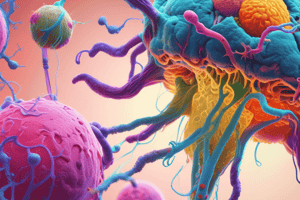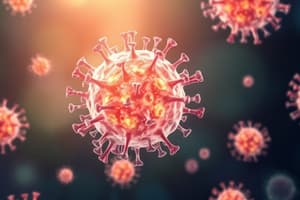Podcast
Questions and Answers
Which effector mechanisms are most effective during responses to intracellular and extracellular pathogens, respectively?
Which effector mechanisms are most effective during responses to intracellular and extracellular pathogens, respectively?
- CD8+ T cells and NK cells; complement activation and antibodies
- Phagocytosis and NK cells; cytokine production and TLR signaling
- CTL’s and macrophage activation; phagocytosis and complement activation (correct)
- Interferons and CTL’s; inflammation and antibody production
What specific immune mechanism is crucial in responding to toxigenic bacteria?
What specific immune mechanism is crucial in responding to toxigenic bacteria?
- CD4+ T cell-mediated cytotoxicity
- Neutralization by high-affinity IgG and IgA antibodies (correct)
- NK cell-mediated killing
- Inflammatory response driven by IL-12 and IL-17
How do bacterial pathogens commonly evade the immune system?
How do bacterial pathogens commonly evade the immune system?
- By inducing antigen presentation via MHC class II
- By expressing polysaccharide-rich capsules and antigenic variation (correct)
- Through overproduction of pro-inflammatory cytokines
- By inhibiting NK cell activation through IL-10 secretion
Which type of T helper cells play a significant role in combating fungal infections?
Which type of T helper cells play a significant role in combating fungal infections?
What is the primary role of Type 1 IFN’s in antiviral responses?
What is the primary role of Type 1 IFN’s in antiviral responses?
Which immune system components are most effective against established viral infections ?
Which immune system components are most effective against established viral infections ?
How do antibodies contribute to antiviral immunity?
How do antibodies contribute to antiviral immunity?
What strategy do viruses use to evade host immune responses?
What strategy do viruses use to evade host immune responses?
How can viruses interfere with antigen presentation?
How can viruses interfere with antigen presentation?
What is the primary immune response mechanism against helminth infections?
What is the primary immune response mechanism against helminth infections?
What immune mechanisms combat arthropod infestations?
What immune mechanisms combat arthropod infestations?
What are the three main innate immunity mechanisms to eliminate extracellular bacteria?
What are the three main innate immunity mechanisms to eliminate extracellular bacteria?
Flashcards
Intracellular Pathogens: Best Defense
Intracellular Pathogens: Best Defense
Cytotoxic T lymphocytes (CTLs) are the primary weapons against intracellular pathogens like viruses and some bacteria. They directly destroy infected cells.
Extracellular Pathogens: Defense Strategy
Extracellular Pathogens: Defense Strategy
Macrophage activation is the key to combating extracellular pathogens. Macrophages engulf and destroy these invaders.
Toxigenic Bacteria: Antidote
Toxigenic Bacteria: Antidote
High-affinity IgG and IgA antibodies neutralize toxins produced by bacteria, preventing their harmful effects on the body.
Bacterial Evasion Tactics
Bacterial Evasion Tactics
Signup and view all the flashcards
Fungal Infections: T Helper Cell Allies
Fungal Infections: T Helper Cell Allies
Signup and view all the flashcards
Type 1 Interferons: Antiviral Arsenal
Type 1 Interferons: Antiviral Arsenal
Signup and view all the flashcards
Established Viral Infections: Immune Champions
Established Viral Infections: Immune Champions
Signup and view all the flashcards
Antibody Power in Antiviral Immunity
Antibody Power in Antiviral Immunity
Signup and view all the flashcards
Viral Evasion Techniques
Viral Evasion Techniques
Signup and view all the flashcards
Viral Interference with Antigen Presentation
Viral Interference with Antigen Presentation
Signup and view all the flashcards
Helminth Infections: IgE and Eosinophils
Helminth Infections: IgE and Eosinophils
Signup and view all the flashcards



